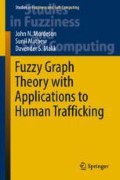Abstract
In 1965, Lotfi A. Zadeh (Fuzzy sets. Inf. Control 8, 338–353, 1965) [34] introduced a new type of set called a fuzzy set and a new logic later known as fuzzy logic. Instead of YES or NO, regarding the existence of an element in a set, he used the degree of membership, which allows an element to exist in a set with a partial grade of membership. The applications of fuzzy logic are profound and widespread.
Access this chapter
Tax calculation will be finalised at checkout
Purchases are for personal use only
References
M. Akram, N.O. Alshehri, Intuitionistic fuzzy cycles and intuitionistic fuzzy trees. Sci. World J. ID 305836, 1–11 (2014). (Hindawi Publishing Corporation)
M. Akram, B. Davvaz, Strong intuitionistic fuzzy graphs. Filomat 26, 177–195 (2012)
M. Akram, M.G. Karunambigai, O.K. Kalaivani, Some metric aspects of intuitionistic fuzzy graphs. World Appl. Ser. J. 17, 1789–1801 (2012)
K.T. Atanassov, On intuitionistic fuzzy graphs and intuitionistic fuzzy relations, in Proceedings of the 6th IFSA World Congress vol. 1 (San Paulo, Brazil, 1995), pp. 551–554
K.T. Atanassov, Intuitionistic fuzzy sets. Fuzzy Sets Syst. 20, 87–96 (1986)
K.T. Atanassov, A. Shannon, On a generalization of intuitionistic fuzzy graphs. Notes Intuit. Fuzzy Sets 12, 24–29 (2006)
K.R. Bhutani, J.N. Mordeson, P.K. Saha, \((s,t]\) -fuzzy graphs, in JCIS Proceedings (2005), pp. 37–40
K.R. Bhutani, A. Rosenfeld, Fuzzy end nodes in fuzzy graphs. Inf. Sci. 152, 323–326 (2003)
K.R. Bhutani, J.N. Mordeson, A. Rosenfeld, On degrees of end nodes and cut nodes in fuzzy graphs. Iranian J. Fuzzy Syst. 1, 57–64 (2004)
C. Caniglia, B. Cousino, S.-C. Cheng, D.S. Malik, J.N. Mordeson, Intuitionistic fuzzy graphs: weakening and strengthening members of a group. J. Fuzzy Math. 24, 87–102 (2016)
Central Intelligence Agency, Field Listing: Trafficking in Persons (2014). http://www.cia.gov/librasry/publications/the-world-factbook/fields/2196.html
P. Chountas, A. Shannon, P. Rangasamy, K. Atassov, On intuitionistic fuzzy trees and their index matrix interpretation. Notes Intuit. Fuzzy Sets 15, 52–56 (2009)
U.S. Department of State, Diplomacy in Action, Trafficking in Persons Report 2013: Tier Placements. http://www.state.gov/j/rls/tiprpt/2013/210548.htm
F. Harary, R.Z. Norman, Graph Theory as a Mathematical Model in Social Science, Ann Arbor, Mich.: Institute for Social Research, 1953)
F. Harary, R.Z. Norman, D. Cartwright, Introduction to digraph theory for social scientists, in Process of Publication
F. Harary, Graph theoretic methods in the management sciences. Manag. Sci. 5, 387–403 (1959)
F. Harary, I.C. Ross, The number of complete cycles in a communication network. J. Soc. Psychol. 40, 329–332 (1953)
F. Harary, I.C. Ross, A procedure for clique detention using the group matrix. Sociometry 20, 205–215 (1957)
A. Kaufmann, Introduction to the Theory of Fuzzy Subsets, vol. 1 (Academic Press, New York, 1975)
G.J. Klir, B. Yuan, Fuzzy Sets and Fuzzy Logic: Theory and Applications (Prentice Hall PTR, Upper Saddle River, 1995)
P.P. Ming, L.Y. Ming, Fuzzy topology I: neighborhood structure of a fuzzy point and Moore-Smith convergence. J. Math. Anal. Appl. 76, 571–599 (1980)
J.N. Mordeson, P.S. Nair, Fuzzy Graphs and Fuzzy Hypergraphs. Studies in Fuzziness and Soft Computing, vol. 46 (Physica-Verlag, Heidelberg, 2000)
J.N. Mordeson, D.S. Malik, C.D. Richards, J.A. Trebbian, M.A. Boyce, M.P. Byrne, B.J. Cousino, Fuzzy graphs and complementary fuzzy graphs. J. Fuzzy Math. 24, 271–288 (2016)
R. Parvathi, M.G. Karunambigigai, Intuitionistic fuzzy graphs. Adv. Soft Comput. 38, 139–159 (2006)
G. Pasi, R. Yager, K. Atanassov, Intuitionistic fuzzy graph interpretations of multi-person multi-critera decision making: generalized net approach, in Proceedings of the 2nd International IEEE Conference in Intelligent Systems (2004), pp. 434–439
D. Rosenblatt, On linear models and the graphs of Minkowski -Leontief matrices. Econometrica 25, 325–338 (1975)
A. Rosenfeld, Fuzzy graphs, in Fuzzy Sets and Their Applications, ed. by L.A. Zadeh, K.S. Fu, M. Shimura (Academic Press, 1975), pp. 77–95
I.C. Ross, F. Harary, On the determination of redundancies in sociometric chains. Psychometrika 17, 195–208 (1952)
I.C. Ross, F. Harary, Identification of the liaison persons of an organization using the structure matrix. Manag. Sci. 1, 251–258 (1955)
I.C. Ross, F. Harary, A description of strengthening and weakening members of a group. Sociometry 22, 139–147 (1959)
M.S. Sunitha, A. Vijayakumar, Blocks in fuzzy graphs. J. Fuzzy Math. 13(1) 13–23 (2005)
M.S. Sunitha, A. Vijayakumar, A characterization of fuzzy trees. Inf. Sci. 113, 293–300 (1999)
E. Takeda, T. Nishida, An application of fuzzy graph to the problem concerning group structure. J. Oper. Res. Soc. Jpn. 10, 217–227 (1976)
L.A. Zadeh, Fuzzy sets. Inf. Control 8, 338–353 (1965)
L.A. Zadeh, Similarity relations and fuzzy orderings. Inf. Sci. 3, 177–200 (1971)
Author information
Authors and Affiliations
Corresponding author
Rights and permissions
Copyright information
© 2018 Springer International Publishing AG
About this chapter
Cite this chapter
Mordeson, J.N., Mathew, S., Malik, D.S. (2018). Strengthening and Weakening Members of a Network. In: Fuzzy Graph Theory with Applications to Human Trafficking. Studies in Fuzziness and Soft Computing, vol 365. Springer, Cham. https://doi.org/10.1007/978-3-319-76454-2_1
Download citation
DOI: https://doi.org/10.1007/978-3-319-76454-2_1
Published:
Publisher Name: Springer, Cham
Print ISBN: 978-3-319-76453-5
Online ISBN: 978-3-319-76454-2
eBook Packages: EngineeringEngineering (R0)

